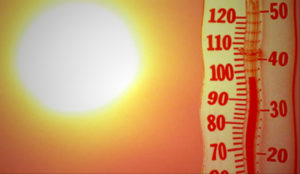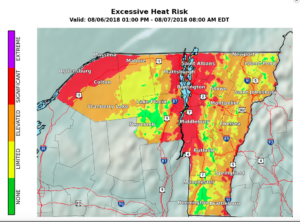It’s hot. This summer heat records have been broken across the Northeast from Burlington, Vermont to Portland Maine and Hartford, Connecticut.
In Burlington, Vermont, we’ve just lived through the hottest month since the National Weather Service began keeping records in 1892. Over the month of July 2018, a new record of 21 days was set for most days above 85 degrees. This surpassed the 20 days in July 1999. Moreover, 10 days were recorded over 90 degrees F and a new record was set for the warmest night, a night-time low temperature of 80 degrees.
As this summer heat takes its toll on Vermonters, the Vermont Department of Health has been monitoring the effects of heat and has found that people are at greater risk for serious heat-related illnesses when the statewide average temperature reaches 87°F or hotter. Based on an analysis of historical data, on days reaching 87°F or hotter:
- Heat-related emergency department visits occurred eight times more frequently
- ED visits were more common for adults 75 and older and teens/young adults 15-34
- There was one additional death per day among individuals age 65 and older
While typically we’ve thought of the elderly, sick and the very young as particularly at risk, what stands out in recent analysis is that young adults are particularly vulnerable. Recent research on college students in Boston showed that heat can slow down reaction times and lowered performance on basic arithmetic tests.
When working in the field or at a farmers market, bear this possible cognitive decline in mind. Vermont Department of Health recommends a number of preventative measures including: –
- reducing outdoor activity during the hottest part of the day
- hydrating, and avoiding alcohol and caffeine if possible
- wearing light-colored and light-fitting clothes
- seeking relief in air-conditioned spaces or other cool & shady places
- keeping living spaces cool by using shades, windows, fans, and avoiding use of oven/stove
- never leaving animals, children, adults with disabilities in a parked vehicle
- learning the signs and symptoms of heat illnesses and basic first aid responses
- checking in on colleagues, neighbors and loved ones, especially those living alone
Know the symptoms of heat illnesses such as muscle cramps, weakness, heavy sweating, nausea, vomiting, and dizziness. These symptoms can usually be treated through rest in a cool, shady place and by drinking cool beverages If symptoms do not improve or if confusion or fainting occurs, you should seek immediate medical attention, as heat stroke can result in death
Unfortunately, the end of is not in sight for heat waves. The number of days reaching a statewide average of at least 87°F is expected to increase in the future due to climate change from 6 days a year (1981-2010 average) to 15 – 20 days by 2050
For any of us working on a farm, avoiding the outdoors is not an option. So taking breaks to stay hydrated and to cool down in shady areas needs to be made a priority and shifting and alternating schedules so that weeding is done in the earliest part of the day when it’s cooler.
Stay informed by:
- Following local weather and news reports,
- Sign up to receive alerts from VT-Alert,
- Checking the NWS Experimental Enhanced Hazardous Weather Outlook. The NWS now issue heat advisories in Vermont when the Heat Index is forecast to be 95-104°F for 2 or more consecutive hours.


